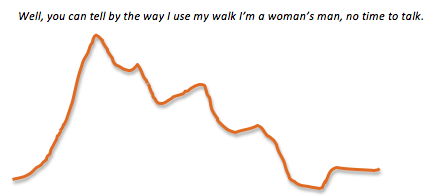 If you’re ready to take your songwriting to its highest level possible, you need “The Essential Secrets of Songwriting 10-eBook Bundle.” Get the manuals that thousands of songwriters are using.
If you’re ready to take your songwriting to its highest level possible, you need “The Essential Secrets of Songwriting 10-eBook Bundle.” Get the manuals that thousands of songwriters are using.
When we talk about a melody’s shape we’re talking about how it moves up and down. That concept of shape becomes more obvious if you were to draw a line that represents the contours of a melody, like this representation of the opening line of The Bee Gees “Stayin’ Alive”:

As you see, it’s a simple line drawing that moves up when the melody moves up, and down when it descends.
This can be an important analytical device because it gives a visual representation of something for which we normally have just an aural representation. Even if you don’t have great ears, you can see that the melody mainly starts with a fairly large leap upward (“Well, you can tell…”), followed by a slowly descending sequence of notes.
So how can you use this technique when you’re trying to improve your songwriting skills? For any song you analyze, it allows you to see if there is a connection between the shape of the melody and the mood we pick up from the lyric.
Most of the time the mood of a lyric — how the writer wants us to feel — is pretty obvious. But it can be very important to see if/how the shape of the melody influences that feeling. Listeners might think that there’s considerable randomness to how a melody moves, but the more you analyze melodies, the more you realize that its shape can play an important role.
So here’s the simple process:
- Choose a song that you know very well, and do a line drawing (like the one above) of one or more lines of lyric.
- Write the lyric above the line.
- Circle key words that you think are powerful parts of the lyric, and draw an arrow pointing to the appropriate spot on your line drawing.
- If you can, write the chord changes at the correct spots on the line. (The more information you gather, the more you’ll ultimately understand about the melody.)
For some songs, you may find that analyzing the melody won’t reveal a whole lot; some songs (even good ones) really aren’t about the melody. But the fact that a certain emotionally charged word happens at a melody’s high moment, for example, can reveal a lot about how we react to that moment in a song.
It can be useful to do this exercise with a verse lyric, and compare the different words we see in the different verses with the same spot on the melody line.
And then going beyond just looking at certain words and where they occur in the melodic line drawing, it’s useful to consider the entire melody’s shape, and how that shape might affect how we feel when we hear the entire song.
By doing this kind of analysis of melodies, we get to see how a melody can take a word or a phrase in a lyric and make it more impactful or meaningful, and then how an entire shape can pair up with an entire verse or chorus lyric.
Most importantly, doing an analytical exercise like this can help to reveal that the best songs are a partnership of several different elements all working together. Line drawings can go a long way to showing how those different elements are actually all working together for the greater good of the song.
 Written by Gary Ewer. Follow Gary on Twitter.
Written by Gary Ewer. Follow Gary on Twitter.
 If you’re trying to make your lyrics a much more important part of your songs, you need to read “Use Your Words! Developing a Lyrics-First Songwriting Process.” It’s part of “The Essential Secrets of Songwriting 10-eBook Bundle.”
If you’re trying to make your lyrics a much more important part of your songs, you need to read “Use Your Words! Developing a Lyrics-First Songwriting Process.” It’s part of “The Essential Secrets of Songwriting 10-eBook Bundle.”










